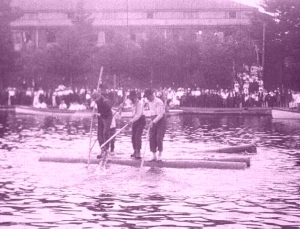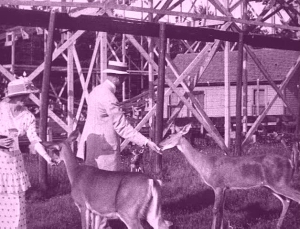The town of Wausau, Wisconsin was keen to publicist itself what better way to display one’s town than to make a motion picture? Locals play all the roles and we are given the grand tour of Wausau as it was in 1914. A charming time capsule.
I sleep all night and I work all day…
The Music Man (1962) is one of my favorite films, bucking my usual dislike of musicals. It tells the story of Professor Harold Hill (brilliantly played by Robert Preston), a confidence man in pre-WWI Iowa who has a sweet racket: He sells unsuspecting towns on the idea of a boys’ band and then he sells them instruments, books and uniforms, too. He is a professor of music, you see, and will stay on to teach and lead the band and… He took the money and left on the midnight train out of town? We have all this band stuff and no one to teach the boys? That dirty crook!

The Music Man is a thoroughly American tale of a charismatic cheat selling big dreams in small towns. If you appreciate its spirit, you are going to love hearing about the background of The Lumberjack.
You probably know about the big studios and you may even be able to name some of the independent concerns of the silent era. The Lumberjack is neither the product of a major studio nor a struggling independent. Rather, it represents a curious little detour in film history, one that had existed from the start of the motion picture industry: the home talent movie. Victorians delighted in seeing themselves and their communities on the silver sheet and the concept of films starring locals for locals would continue into the sound era.

By the time The Lumberjack entered production, the deal would go down like so: A motion picture company would offer to make a motion picture in town, showing off the local sights and wonders. The parts would all be played by hometown boys and girls, an exciting prospect at a time when movies were finally being considered suitable for family outings. Of course, the idea was to publicize the community in question but without the distribution channels of larger studios, most of these films were just screened within city limits and then forgotten.
(If you wish to learn more about this curious bit of film history, I recommend checking out David Shepard’s Itinerant Film Resource Guide.)

The Lumberjack is a typical home talent movie, one of the few to survive. We’re going to take a look and see how it holds up for modern viewers and then we’re going to discuss its production, including a rather nasty death.
First thing’s first, though. Let’s get this out of the way: He’s a lumberjack, he’s okay, we’re all okay. Now, onward to the review!

The Paragon Feature Film Company, Inc. certainly splashed its logo all over the main titles, didn’t it? Real life local couple Hans and Helen Hagge play Jack Norwood and Marie McMillan, a courting pair. The plot is basically as follows:
Jack and Marie arrange to see the sights of Wausau. A little later, they go look at something and then Jack takes Marie home. Later, he picks her up again, they see more stuff and then he takes her home again. Then a fire breaks out at Marie’s house (well, a smoke pot on the porch) and Jack goes and carries her out and her father says he can marry her. Awww!

Of course, the plot is all an excuse to show off the wonders of Wausau and it is a great deal of fun to see what a 1914 American town looked like when it was putting its best foot forward. We are shown stately homes, civic buildings and boat races (the crowds were so great that a bridge rail collapsed, giving everyone a good ducking) but most attention is paid to the lumber industry, both old-fashioned (logrolls!) and modern (sawmill). And no, we never do learn who the lumberjack of the title is supposed to be. The filmmakers also planned to shoot a blast the local rock quarry and this is where the story goes from cute to tragic.

Some of the employees of the quarry had expressed concern about the filming. In order to get a good shot, the film crew would be within range of the debris from the blast they hoped to capture on film. Everyone’s worst fears were realized when Edward Rosenthal, secretary and treasurer of the Paragon Film company, was struck in the heart by a flying rock and killed instantly.
This terrible accident soured the mood of the production. What was supposed to have been a fun publicity stunt for the town had senselessly taken a life. The production was completed but the picture was rarely mentioned after its initial screening. It certainly did not fulfill its mission of putting Wausau on the map.
The film remained unseen for decades before its rediscovery. Before we talk about the enjoyment factor for modern viewers, let’s get technical. The Lumberjack has a surprisingly nimble camera considering its date of production and budget, though I suspect that most of the pans were actually compensation for poor blocking and framing. Certainly, the camera movement is on the jerky side. Other than that, the film is created in a workmanlike manner. Capture the action and move on to the next event.

It would be a bit loutish, though, to focus too much on the technical deficiencies of The Lumberjack. It would be like a big city dramatic critic picking apart a cheerful community theater production. Artistry is beside the point because charm and history are blending a delightful cocktail. The enthusiasm displayed by the local cast and their obvious pride in their charming community more than makes up for a lack of closeups and narrative sophistication. We are given a peephole into an innocent and optimistic world that would not survive into the new decade. That has to be worth something.

The Music Man famously ends with the boys playing their little hearts out (Professor Hill is threatened with a tar-and-feathering if they do not deliver) and their off-key rendition of Beethoven’s Minuet in G is just as awful as can be. The big twist is that it doesn’t matter one bit. To proud parents, the sour notes sound as sweet as can be and the whole town joins in a triumphal march to celebrate their wonderful band.
That’s kind of what The Lumberjack is like. Its plot is just an excuse to drive around Wausau and see the sights. Its characterization is shallow and the whole undertaking is as naïve as can be. But you know what? I had just as much fun with this picture as I have had with dozens of brilliant short films from the same period. Its flaws are glaring but I loved every bit of it. In fact, I was a bit surprised when it was over because the time passed so quickly. At fifteen minutes, it’s certainly a quick watch.

Movies Silently’s Score: ★★½
Where can I see it?
The Lumberjack has been released on DVD by Flicker Alley as part of their We’re in the Movies anthology. The set includes other local films and the charming hour-long documentary When You Wore a Yellow Tulip and I Wore a Big Red Rose (1983), which tells the tale of The Lumberjack. Stephen Schaller tracks down surviving cast members, the descendants of the movers and shakers behind the film and scouts the locations. It’s a great deal of fun with his musical interview of silent film accompanist Louise Elster being a particularly delightful highlight. The anthology is absolutely wonderful and I recommend it without reservation.


I would love to see this film even if it seems there is not much goi g on I. The lumberman area. I grew up on a sawmill and my dad, who was born in 1913, was a lumberman for most of his life. He worked in Algonquin Park during the 1930’s and was out west. He did ride a log on the river and once saw a man all in between the logs and then the logs closed up and he was gone. We did have a very old fashioned sawmill that was 100 years old and I grew up with that.
Very cool! Yes, I’m sure you will find a lot to enjoy about this picture 🙂